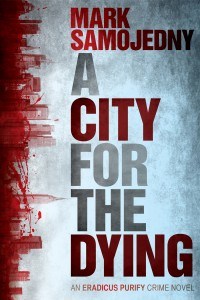 No doubt the kick-ass reluctant-hero-with-a-tortured-soul in this debut novel will achieve rock star status with readers. But let’s not leave the author out of the limelight. In his debut crime thriller Mark Samojedny kills it with mechanical craft, weaving metaphor and mysticism into the action in a mean, lean style guaranteed to leave the audience screaming for an encore.
No doubt the kick-ass reluctant-hero-with-a-tortured-soul in this debut novel will achieve rock star status with readers. But let’s not leave the author out of the limelight. In his debut crime thriller Mark Samojedny kills it with mechanical craft, weaving metaphor and mysticism into the action in a mean, lean style guaranteed to leave the audience screaming for an encore.
The title sets the mood for us. The cover artwork shows a city turned on its side—a spiffy, enticing vision complementing the story elements. The internal design echoes the cover. The front matter doesn’t bother with chapter titles or a contents page, but simply dives into the story, as expressed in the epigraph: “Leap and the net will appear.” Chapters are short, with overlapping POV switches that replay, rather than rehash, the action.
Through a consistently balanced use of description, dialogue, thoughts, and action we watch various characters navigate their immediate situations in terms of their surroundings as they attempt to buck their lots in life by achieving their individual plans. This is a complicated business, as the characters all have something else in common: Rationalization.
In A City for the Dying we find our protagonist, Eradicus Purify, in a bothered state from the first line. Samojedny lays out the bare bones of the plot within the first 20 pages while introducing some tantalizing themes: judgment of others, self-expectations, family loyalty, and how to transcend social class (or whether we can).
On that last point, Eradicus has a love interest, Alexa, a hot “Vinings girl” with a rich lawyer daddy, while his own father is a warehouse shift manager in Strickland, and their budding relationship sometimes echoes the tension between the two towns. But the most challenging lesson Eradicus will ultimately be faced with comes from his dad: “It’s not what you do that matters, it’s why you do it.”
With all of this going on, Eradicus will be pulled into a very dangerous situation: “Relax,” Ted said, “what is Carlos going to be able to do about it here in the States? File a police report for 18 million dollars’ worth of stolen Oxycontin?”
Samojedny’s use of lyrical prose to describe characters is impressive, as with Ted: Ten years ago his hair started to fall out and now sprouts of wispy gray hair made his skull, size eight for a fitted hat, look like a deserted inner city lot slowly being overtaken by tufts of weeds.
I finished the novel having found only a few possibly personal insertions from Samojedny—but nothing to indicate he wanted to convince me of anything socially or politically. This makes the book easy to enjoy. Grammar and punctuation errors are under a dozen by my count and don’t distract from the reading but a last clean-up wouldn’t hurt. I found no problems with tenses, modifiers, clichés, or ridiculously unnecessary multi-syllabic words.
I found myself savoring Samojedny’s use of setting to enhance plot tension. Something else he is good at is planting a seed. There are several references to a Mexican legend (Even now as they waited for Alexa to appear, his hands clutched a tattered Malverde prayer card his mother had given him before crossing the border), with an interesting parallel between Javier heeding his mother’s words and Eradicus constantly returning to his own mother’s advice (“You can do this”).
A ripped-from-the-headlines question gives the plot its urgency: what if the violence in Mexico spilled over into the United States? I found some comparisons between the real-life Rio Grande (separating Mexico and the U.S.) and the fictional Badger River (separating Strickland and Vinings). In one of my favorite passages from the book, this ‘river as separation’ theme hits home: “If the thunder could travel throughout all of Mexico, shouldn’t the people in the United States have been able to hear it as well? Or did the thunder stop at the border? Maybe the thunder did not have the bribe money needed to get across the border.”
While the pretend locales of Strickland and Vinings are metaphors for the encroachment of wealth upon blue collar neighborhoods and the plot relies heavily on what is popularly known as The War on Drugs, the real fight of the story lies within Eradicus Purify. In the words of the great Mexican writer Octavio Paz: “To fight evil is to fight ourselves.” Will Eradicus learn his lesson as to the why in life? He seems to think he has, but we’ll have to read the sequel to find out if it sticks. I rate this book five stars.
About the Author
Mark Samojedny graduated from the University of Wisconsin-Madison, majoring in Journalism. He currently lives in the Chicago area where he is at work on his second novel. A City for the Dying is the first in a series of novels featuring Eradicus Purify.
Links
Get an Editorial Review | Get Amazon Sales & Reviews | Get Edited | Get Beta Readers | Enter the SPR Book Awards | Other Marketing Services






















Leave A Comment